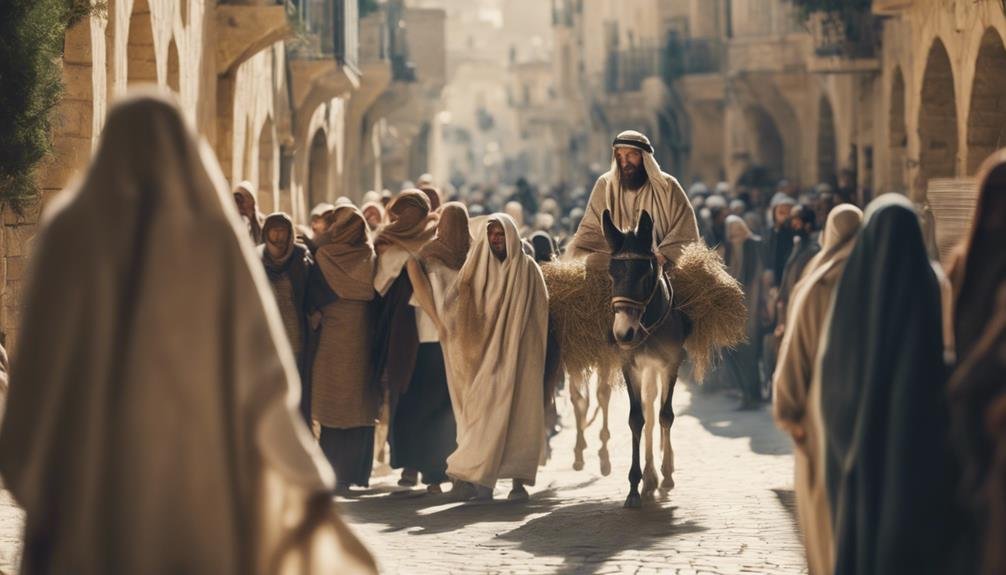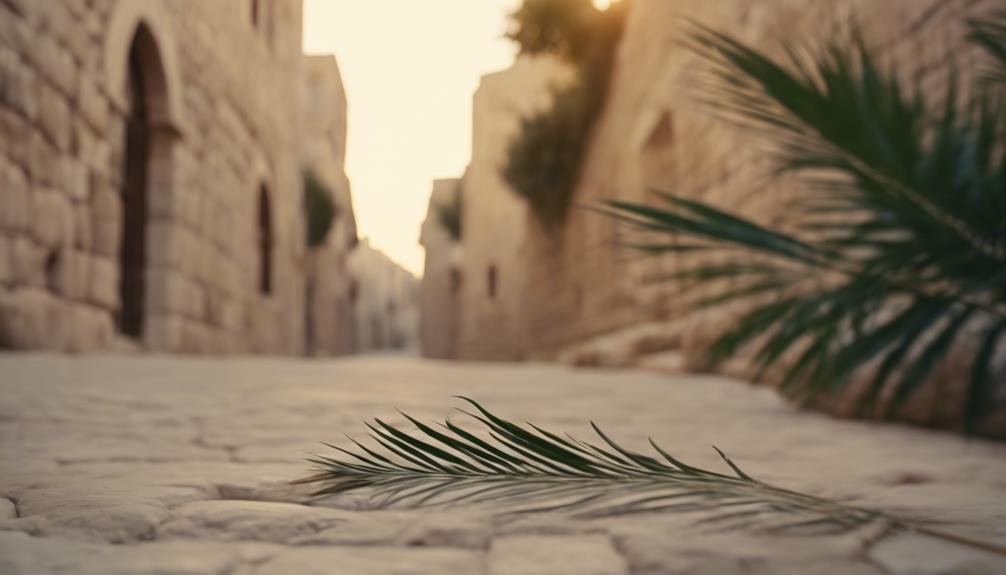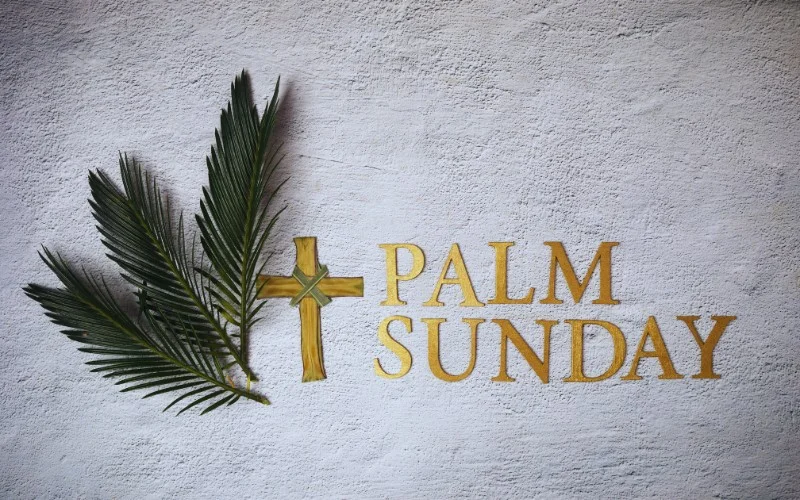You’ve likely heard about Palm Sunday, but have you ever explored the fascinating prophecy that foretells this event? Consider Zechariah’s prediction of a king arriving in Jerusalem on a humble donkey, symbolizing significance and humility.
This imagery sets the stage for Jesus’s dramatic entry and intersects with Daniel’s precise timeline, which predicts the Messiah’s arrival.
As you reflect on these ancient texts, think about how they underscore a narrative of peace—contrasting sharply with the usual depictions of kingship. What might this paradox tell us about the nature of true leadership? This question hangs in the air, hinting at deeper layers of meaning yet uncovered.
Key Takeaways
- Palm Sunday fulfills Zechariah’s prophecy of a humble king entering Jerusalem on a donkey.
- The event aligns with Daniel’s prophecy regarding the timeline of the Messiah’s arrival.
- Jesus’ entry on a donkey, a symbol of peace, contrasts with traditional images of kingly power.
- Palms waved by the crowd symbolize triumph and victory, echoing messianic expectations.
- The fulfillment of these prophecies on Palm Sunday solidifies Jesus’ identity as the Messiah.
Historical Context of Palm Sunday

Palm Sunday marks the beginning of Holy Week, commemorating Jesus Christ’s triumphant entry into Jerusalem nearly two millennia ago. As you explore this historical event, you must grasp the backdrop of Roman occupation and traditional Jewish customs that defined the era.
During this period, Rome held a firm grip on Jerusalem, imposing its authority over the Jewish population. This occupation influenced daily life, from governance to religious practices.
Roman soldiers would enforce peace, often with a heavy hand, amid a populace clinging to its cultural and religious identity.
Amid these tensions, Jewish customs continued to play a pivotal role in community cohesion and identity. The celebration of Passover, which coincides with Holy Week, is a prime example.
This festival commemorates the Israelites’ liberation from ancient Egypt, resonating deeply with themes of oppression and hope. Jesus’ entry into Jerusalem on a donkey, fulfilling prophetic symbolism, was a powerful gesture.
It recalled Jewish kingship traditions while also signifying peace, contrasting sharply with the typical warhorse symbol of Roman conquerors.
This layered context of occupation and enduring cultural rituals sets the stage for understanding the profound impact of Palm Sunday and the events that followed.
Prophecies Foretelling the Event
Several prophecies in the Hebrew Scriptures specifically foretold the events of Palm Sunday, highlighting its significance in the unfolding biblical narrative. Among these, Zechariah’s vision and Daniel’s timeline are particularly poignant.
Zechariah prophesied about a king coming to Jerusalem, humble and riding on a donkey, a clear foretelling of Jesus’ entry into the city. This vision isn’t just about the mode of transport; it symbolizes peace and humility, contrasting sharply with the typical image of a conquering king on a horse.
Now, let’s dive deeper into Daniel’s timeline. Daniel provides a detailed prophecy about the timeline of significant events leading to the Messiah. His precision in outlining the years until the coming of an “anointed one” aligns remarkably with the timeline of Jesus’ arrival in Jerusalem.
Here’s a quick comparison:
| Prophet | Key Aspect of Prophecy |
|---|---|
| Zechariah | Humble king on a donkey |
| Daniel | The exact timeline to Messiah |
| Both | Highlight peace and humility |
| Impact | Validates Jesus’ messianic role |
Symbolism of the Palm Branches

As you explore the significance of Palm Sunday, consider how the palm branches used by the crowd symbolize victory and triumph. These branches aren’t just crucial agricultural products and potent symbols in many cultures.
Historically, warriors and champions were often greeted with palms, signifying their success and courage. This tradition underscores the branches’ role during Palm Sunday, marking Jesus’s triumphant entry into Jerusalem as a spiritual victor.
The cultural uses of palm branches extend beyond mere symbols of triumph. In various societies, palms are woven into religious and community celebrations, often used to decorate and sanctify spaces for special occasions.
Their presence on Palm Sunday connects the faithful with a wider historical and cultural context, enriching the spiritual experience.
Moreover, palms’ essential significance can’t be overlooked. These trees are crucial to the economies of many regions, providing food, shelter, and raw materials.
This economic importance adds a layer of depth to the symbolism on Palm Sunday, reminding you of the sustenance and protection that faith offers in times of spiritual and physical need.
Significance of the Donkey
The donkey Jesus chose to ride into Jerusalem symbolizes humility and peace. This choice was far from random and steeped in symbolic meaning you’re meant to understand.
In biblical times, donkeys were seen as animals of peace, unlike horses, who were often associated with war. This animal’s humility comes to the forefront, highlighting Jesus’ mission to connect with the meek and the humble.
In donkey symbolism, there’s a unique blend of servitude and strength. You’ll find that, unlike horses, donkeys aren’t typically symbols of wealth or power. Instead, they represent an enduring, patient laborer.
By choosing such a mount, Jesus emphasized service and peace over dominion and power. It’s a stark reminder of the values you’re called to embrace.
The donkey also upends conventional expectations of a messiah’s arrival. Instead of a grand chariot or a majestic horse, the choice of a simple donkey as his steed resonates deeply with themes of modesty.
You’re seeing a leader who’s approachable, not aloof, grounded, not grandiose. This animal humility, then, isn’t just about the donkey—it’s about a broader spiritual lesson that’s as relevant today as it was back then.
Jesus’ Route Into Jerusalem

Jesus chose a path through the Mount of Olives to enter Jerusalem, fulfilling ancient prophecies as he did so. You’d envision the scene as both solemn and jubilant.
As Jesus descended towards the city, the crowd size began to swell. People gathered, excited to witness this moment, lining up along the route with palpable anticipation.
Security measures at that time were rudimentary compared to today’s standards. Yet, Roman soldiers and Temple guards would have been noticeable, their eyes scanning the crowd for any sign of unrest. You’d feel the tension between the masses’ celebratory mood and the authorities’ wary alertness.
Here’s a breakdown of the key aspects of Jesus’ entry:
| Aspect | Details |
|---|---|
| Route | Mount of Olives to Jerusalem |
| Crowd | Large, enthusiastic |
| Security | Roman soldiers, Temple guards |
| Significance | Fulfillment of prophecies, symbolic entry |
This route wasn’t just a geographical choice but a profound statement woven with historical and spiritual threads that signaled the coming change. As you envision this, imagine the mixed emotions – hope, fear, and awe – that might have filled your heart witnessing such a pivotal moment.
Public Reaction and Interpretation
While Jesus entered Jerusalem, diverse reactions rippled through the gathered crowds, reflecting a spectrum of interpretations and emotions. You’d have seen the varied faces—some awed, others skeptical.
This moment, layered with profound significance, wasn’t just a spectacle but a pivotal scene in religious history. Had it existed in contemporary forms, the media portrayal of this event would’ve amplified every shout and whisper, broadcasting the mixed sentiments to a wider audience.
Today, you witness a cultural adaptation of this scene in various mediums—films, plays, and art—each interpreting the entrance with its unique lens. These adaptations influence how you perceive the event and the figure of Jesus himself.
Imagine the chatter on the streets and in homes post-event, similar to the buzz on social media platforms. Both informed and uninformed opinions would spread, morphing the original narrative. This blend of reverence and doubt, captured and recast through various cultural prisms, shows how a single event can echo differently across ages.
You’re part of a continuum, engaging with a historical moment that’s been retold countless times, each retelling shaded by the biases and beliefs of its era. How you understand Palm Sunday today is a tapestry woven from centuries of public reaction and interpretation.
Implications for Messianic Identity

Jesus’ entry into Jerusalem on Palm Sunday not only fulfilled ancient prophecies but also solidified his identity as the Messiah in the eyes of many followers. You might imagine the scene that fateful day, a moment of divine authentication that sparked countless theological debates.
Crowds waving palm branches, a traditional symbol of triumph and victory, created a path as Jesus rode the humble donkey. The shouts of ‘Hosanna!’ echoing through the air, a plea for salvation now turned into a declaration of praise.
Children and adults spread their cloaks on the ground, a gesture of respect and submission to one they deemed king. The bewildered faces of Jerusalem’s elite, their discomfort palpable as the people hailed this humble teacher from Nazareth as their deliverer.
These vivid images reflect the profound impact of that day. It wasn’t just about fulfilling the words of prophets; it was a public endorsement of Jesus’ messianic claim.
Each act and shout from the crowd was deeply tied into the woven narrative of Jewish expectation and Christian theology, challenging and changing religious thought and identity. As you reflect on this, consider how these events continue to resonate, shaping spiritual perspectives and beliefs.
Reflections on Modern Celebrations
Reflecting on the modern celebrations of Palm Sunday, you’ll notice how these traditions connect believers with the historical event. It’s fascinating to see global variations in the observance of this day.
In some countries, elaborate processions are common; in others, the focus is on intimate church services. Yet, despite these differences, the core message of reflection and anticipation remains the same.
You’ll also find that ecumenical services have become a significant aspect of Palm Sunday in many communities. These joint services bring together different Christian denominations to celebrate the start of Holy Week.
It’s a powerful testimony to unity and shared faith, transcending individual doctrinal differences. You’ll likely see Catholics, Protestants, and Orthodox Christians walking side by side, each bringing unique elements to the celebration yet focusing on the central story of Jesus’ triumphant entry into Jerusalem.
These modern practices enrich your understanding of Palm Sunday and offer a moment of collective meditation and spiritual renewal.
As you participate or observe, you engage with a living history, a tradition that has adapted yet remained rooted in its origins, bridging past and present in meaningful ways.
Conclusion
As you reflect on Palm Sunday, remember the profound fulfillment of ancient prophecies that marked this day. The humble entry on a donkey and the palm branches waving in the air weren’t just symbols but powerful affirmations of Jesus’ identity as the Messiah.
Today, as you celebrate, you’re not just remembering a historical event but engaging in a tradition that underscores peace, humility, and the enduring hope of redemption that Jesus brought into the world.
Explore More Articles:
7 Best Online Streams for Sunday Church Services
Palm Sunday Blessings: Inspiring Quotes for a Sacred Journey
Top Family Activities for a Joyful Palm Sunday: Bonding Moments

